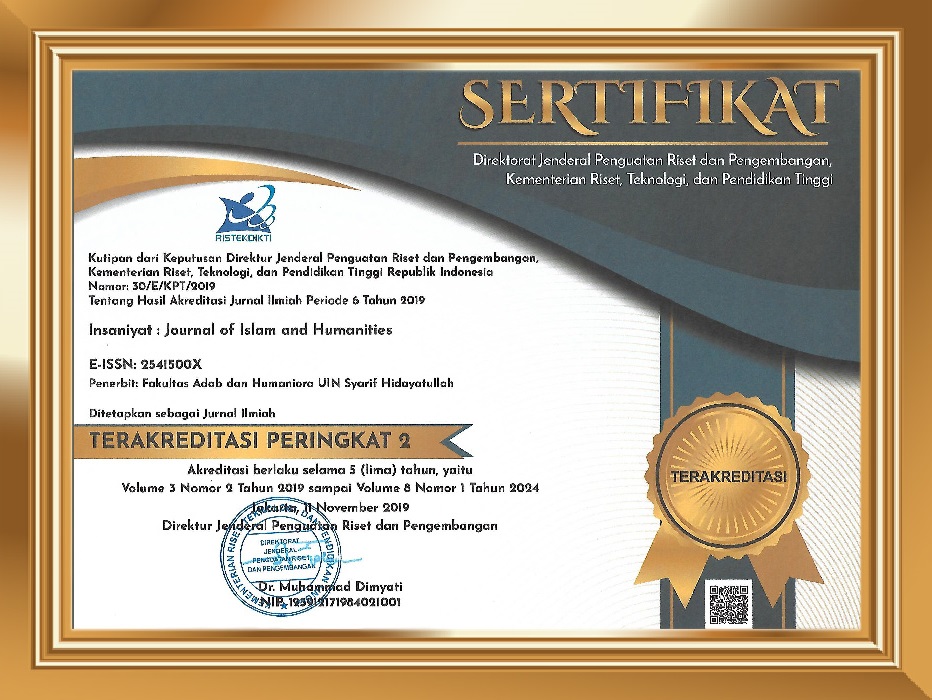Representation of Islam Identity in Khanzab: An Indonesian Horror Film
Abstract
Keywords
References
Afiyatin, Alfiyah Laila. 2019. “Ruqyah Sebagai Pengobatan Berbasis Spiritual Untuk Mengatasi Kesurupan.” Hisbah: Jurnal Bimbingan Konseling Dan Dakwah Islam 16(2):216–26. doi: 10.14421/hisbah.2019.162-09.
Aini, Putri Rizki. 2023. “The Relationship of Prayer and Patience as an Analysis Help QS . Al-Baqarah Verse 153.” 12(03):2645–49.
Akmaliah, Wahyudi. 2020. “When Islamism and Pop Culture Meet: A Political Framing of the Movie ‘212: The Power of Love.’” Studia Islamika 27(1):1–33. doi: 10.36712/sdi.v27i1.9205.
Annissa, Larasati Winda, and Justito Adiprasetio. 2022. “Ketimpangan Representasi Hantu Perempuan Pada Film Horor Indonesia Periode 1970-2019.” ProTVF 6(1):21. doi: 10.24198/ptvf.v6i1.36296.
Azis, A. A. 2020. “The Use of Traditional Conflict Resolution : A Case Study of Timor Leste.” doi: 10.4108/eai.26-11-2019.2295153.
Chen, Xiaowen. 2023. “The Movie Culture of U.S.” Pp. 839–44 in Proceedings of the 2022 4th International Conference on Literature, Art and Human Development (ICLAHD 2022). Paris: Atlantis Press SARL.
Debby, Yohana, Theresia Intan Putri Hartiana, and Nanang Krisdinanto. 2020. “Desakralisasi Film Horor Indonesia Dalam Kajian Reception Analysis.” ProTVF 4(1):1. doi: 10.24198/ptvf.v4i1.24171.
Edet, Francis Felix. 2019. “The Concept of Worship in Islam Francis.” LWATI: A Journal of Contemporary Research 16(4):1–23.
Hardiyanti, Kiki Maulfi, and Muchlis. 2020. “The Da’wah Message in an Indonesian Horror Film (Case Studies on Film Pengabdi Setan Using A Semiotics Model Roland Barthes).” Proceedings of International Conferenceon Da’wa and Communication 2(1):308–24.
Hasanain, Muh, and Baiq Muslimatusshalihah. 2021. “Reactualize the Role and Function of Mosque in Developing the Education of Ummah: Study in East Lombok West Nusa Tenggara Province.” International Journal of Multicultural and Multireligious Understanding 8(10):510–16.
Ilham. 2022. “Hukum Sumpah Pocong Dan Mubahalah Dalam Islam.” Muhammadiyah. Retrieved May 15, 2024 (https://muhammadiyah.or.id/2022/09/hukum-sumpah-pocong-dan-mubahalah-dalam-islam/).
Justine, Felicia, Karina Jodie, Muhammad Rafi Alfajri, Muhammad Syakir A. R. U. Dilo, and Zidan Hidayat Al Kautsar. 2021. “Budaya Mengaitkan Berbagai Peristiwa Dengan Hal Mistis Oleh Masyarakat Indonesia.” Jurnal Kewarganegaraan 5(2):602–11. doi: 10.31316/jk.v5i2.1953.
Khalifa, Haifa Ebrahim Mohamed Al. 2023. “Spiritual Sensory Theory and Bodily Experiences Keys for Successful Mosque Design.” New Design Ideas 7(2):243–64.
Loyd, Aerika Brittian, Dulce Wilkinson Westberg, Le Nisha Williams, Marisha Humphries, Alan Meca, and Julie C. Rodil. 2023. “‘I Just Want to Be Me, Authentically’: Identity Shifting Among Racially and Ethnically Diverse Young Adults.” Journal of Youth and Adolescence 52(4):701–18. doi: 10.1007/s10964-023-01744-3.
Lubis, Muhammad Jihad Azni, and Mardian Idris Harahap. 2023. “Implementation of Mosque Functions in Teluk Nibung District in the Perspective of Wahbah Az-Zuhaili.” El-Umdah: Jurnal Kajian Ilmu Al-Qur’an Dan Tafsir 6:183–201.
Manurung, Elvy Maria, and Daniel Daud Kameo. 2021. “Creativity and Its Paradoxes: How the Indonesia Movie Industry Can Survive.” Jurnal Ekonomi Dan Bisnis 24(1):27–46. doi: 10.24914/jeb.v24i1.3289.
Mukarromah. 2021. “A Semiotic Analysis of Sumpah Pocong Among Maduranese People: A Case Study of Polagan District, Sampang-Madura.” Lakon : Jurnal Kajian Sastra Dan Budaya 10(2):64. doi: 10.20473/lakon.v10i2.30102.
Nurhuda, Abid, Dewi Sinta, Inamul Hasan Ansori, and Nur Aini Setyaningtyas. 2023. “Flashback of the Mosque in History: From the Prophet’S Period To the Abasiyyah Dynasty.” LISAN AL-HAL: Jurnal Pengembangan Pemikiran Dan Kebudayaan 17(2):241–50. doi: 10.35316/lisanalhal.v17i2.241-250.
Nurjannah, Mauliya Redyan, Dewi Eka Wulandari, and Latifur Rohmah. 2024. “Revitalization of Mosque Functions in Society Empowerment ( Case Study of Suciati Saliman Mosque , Yogyakarta ).” 2(2023):1066–75.
Obead, Hassan Hameed, and Salman Ali. 2023. “Islamic Identity in Light of Contemporary Intellectual Challenges.” Journal for Educators, Teachers and Trainers 14(5):588–602. doi: 10.47750/jett.2023.14.05.052.
Pramudyah, Gea, and Azizah Amini binti Amin. 2023. “The Dangers of Witchcraft in the View of Hadith: A Study of Takjrij and Hadith Syarah.” Journal of Takhrij Al-Hadith 2(2):49–57.
Rafique, Shanawer, Mohsin Hassan Khan, and Hira Bilal. 2022. “A Critical Analysis of Pop Culture and Media.” Global Regional Review VII(I):173–84. doi: 10.31703/grr.2022(vii-i).17.
Ridho, Ali, Mahfuzah Saniah, Joko Prayudha, and Idi Warsah. 2023. “Manipulasi Religiusitas: Analisis Kritis Terhadap Fenomena Pendistorsian Nilai-nilai Sakral Agama di Indonesia.” Journal For Islamic Studies 6(2):31–48. doi: 10.1051/e3sconf/202124411036.1.
Ridwan, Aang. 2019. “Commodification and Commercialization of Islamic Da’wah Practice on Indonesian Television.” Ilmu Dakwah: Academic Journal for Homiletic … 13(April):175–96. doi: 10.15575/idajhs.v13i1.4930.
Rosida, Ida, and Tuty Handayani. 2023. “Women, Gossip, and Film: Social and Cultural Construction on Women’s Behavioral Engagement in Gossiping.” International Journal of Media and Information Literacy 8(1):191–203. doi: 10.13187/ijmil.2023.1.191.
Rostami, Soheila, and Wrya Hafidi. 2024. “The Effect of Prayer on Mental Health from the Perspective of the Qur ’ An.” The Islamic University College Journal.
Salim, Rizky Sulaiman, Akbar Ramadhan Muhammad, and AG Eka Wenats Wuryanta. 2020. “Komodifikasi Kesenian Wayang Kulit Dalam Film Perempuan Tanah Jahanam Perspektif Marxian.” Jurnal Ekonomi, Sosial & Humaniora 01(12):37–48.
Setyaningsih, Tri Widyastuti. 2023. “Rekreasi Ketakutan, Sebuah Kajian Menonton Film Horor Di Masa Pasca Pandemi.” IMAJI: Film, Fotografi, Televisi, & Media Baru 14(1):57–72. doi: 10.52290/i.v14i1.100.
Stuart, Hall. 1997a. Representation Cultural Representations and Signifying Practices. SAGE Publication Ltd.
Stuart, Hall. 1997b. “Representation and the Media.” Media Education Foundation.
Suroyya, Dhama. 2022. “Komodifikasi Dan Deskralisasi Simbol Agama Dalam Film Horor Indonesia Commodification and Desacralization of Religious Symbols in Indonesian Horror Movies.” Journal of Islamic Communication 5(1):15–38.
Widodo, Jordy Satria. 2022. “The Representation of the Islamic Religious Leader in Film ‘Makmum’ by Riza Pahlevi.” Journal Albion: Journal of English Literature, Language, and Culture 4(1):13–17.
DOI: 10.15408/insaniyat.v9i2.41653
Refbacks
- There are currently no refbacks.






